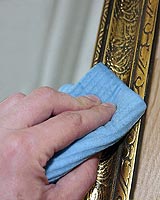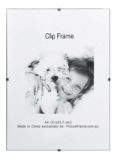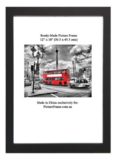In this page “Picture Frames and Art Care” we cation that loose Loose , unframed, soft strata art on paper or canvas art should be never be creased, folded or rolled up but kept flat! This is because a medium such as paper is made up of layers which retain a “memory”.
If it is bent or rolled up, its layers  will dry out and largely stay in the round, curled up position. When unrolled or flattened, paper can easily crack, split and break. See the example of damaged oil on canvas herein. With picture frames, framed paintings or any art for that matter, these objects should never be stacked on top of one another.
will dry out and largely stay in the round, curled up position. When unrolled or flattened, paper can easily crack, split and break. See the example of damaged oil on canvas herein. With picture frames, framed paintings or any art for that matter, these objects should never be stacked on top of one another.
The paint may rub, scratch and the gesso even fall off in chips. Avoid touching canvases or boards whenever possible, especially the surfaces. Handle a canvas by the edges, as you would a photograph. Paintings should be stored under stable conditions, neither too dry nor too damp. 50% relative humidity at around 20°C.
Works on paper, even cheap tourist Asian holidays oil paintings, should never be rolled up in shipping tube for any length of time. Instead it ought to be carried and transported only in acid-free paper folders, solander boxes or an artist’s portfolios.
Most modern art and papermaking are derived from commercial wood pulp produced by mechanical wood pulping, a process first invented in the early 1800’s. While it is cheap, in order to make paper affordable for as many consumers  as possible, it unfortunately either contains or is treated by or with sulfurous acids, lignin, sulfite and sulfates, to name a few chemicals.
as possible, it unfortunately either contains or is treated by or with sulfurous acids, lignin, sulfite and sulfates, to name a few chemicals.
These elements are linked to the embrittlement and “yellowing” process that damages most modern paper art, caused largely by two factors. The first is often the poor quality paper the artwork is made of which usually contains lignin (also found in the timber of picture frames), and other potential acid sources, that cause it to gradually discolour yellow or brown with age.
The second is often improper of incorrect picture framing. If the artwork is properly conservation picture framed, then the discolouration and deterioration processes may be significantly retarded. The best way to prevent or to decelerate discolouration and yellowing is to use conservation materials, processes and techniques to prevent acid leaching or contamination to the paper-borne artwork.
Mildew and mould are made up of fungi which often leave white and green mould, fungi and brownish spots (foxing) on paper-borne artwork.  Their presence frequently results in unsightly damage to the surface and fiibres or art on on paper, canvases and discolouration of matboard, picture frames and photo frames.
Their presence frequently results in unsightly damage to the surface and fiibres or art on on paper, canvases and discolouration of matboard, picture frames and photo frames.
These organisms prefer dark, dank or damp areas where humidity may exist from a variety of moisture sources. Inside houses, all picture frames should be hung with bump-ons, or felt-dots, at the back where the corners of the frame touch the wall.
This tends to bring both light and air behind the picture frame. You should also regularly dust, clean and inspect all frames and consult a picture framer if in doubt. Unframed art should be stored in flat, in solander boxes or artists’ portfolios to protect the art from light and dirt. If simply storing your prints, posters, documents or other art on paper at home, try to avoid storing art in attics or basements.
The reason for this is that both of these areas, unlike living areas, can experience extreme changes in light, humidity and temperature. There’s also the added danger of likely, and nearby, drainage, heating, plumbing pipes, wires and power systems. Any and all of these could leak, seep, break malfunction, thus adversely affecting or even damaging any stored art in the proximity. This is why art should should only be stored in areas or rooms above the ground level, off of the floor.
It is not widely known that even relatively short exposure to artificial or natural light can cause damage to fine art and photographic materials. This damage includes but is not limited to fading and tonal aberrations with accelerated,  deteriorating processes.
deteriorating processes.
Direct or indirect, even ambient daylight rays will fade the gelatin, media or inks in a photograph or art on paper by “bleaching” the colours in the artwork. The most harmful are the ultraviolet or “UV” component of visible daylight. For artificial lighting, the high energy Ultraviolet “UV” content, is controlled by using incandescent lights instead of fluorescent lighting, which has a higher UV emission.
Light damage is irreversible and cumulative, and all genres of fine art and photographs are vulnerable. The most susceptible to light are salted paper prints, albumen silver prints, and colour prints. UV filters are used in locations where low UV light sources cannot be used.
For framed art, picture frames usually are fitted with UV-filtering acrylic glazing, instead of clear, float glass. This is because ordinary, clear picture framing glass blocks over half of the “UV” rays but this is not enough to conserve colours or avoid fast fading. In addition, it is recommended to display such art at low light levels, away from strong light sources such as windows that do not have light-blocking curtains.
The recommended light level for displaying photographs at the Gallery is around 50 Lux. For this reason art galleries exhibitions display framed art and other delicate art on paper in more dimly locations than those exhibiting paintings, ceramics or sculptures.
Pertinently, the conventional duration of public display time maintained by art galleries is often limited to approximately 90 days every two or three years to reduce accumulated light damage. To greatly retard fading, since absolute prevention is almost impossible, consider asking your picture framer to glaze your artwork with “UV” filtering glass.
While this type of glazing is dearer, it has been proven to block over 97% of the harmful “UV” rays. In Australia, picture frames glass is generally available as clear, non-glare (etched on one side to reduce reflection) or diffused, “UV” filtering clear and museum quality.
The latter is quite expensive, with “UV” filter and a non-reflective on surface that does not have a diffusing effect. To sum it up, consider glazing your artwork according to or commensurate to its origins and value, be this emotional, historical of financial.
Conservation picture framing ecompasses the methods, materials and processes employed by professional picture framers to conserve and preserve, with as minimal deterioration as possible, the original condition of the art being framed.
This specialized framing process must also embody the principle of reversibility, ie:, the frame art or item must be capable of  being safely deframed, de-mounted, disassembled and detached should the need arise to do so in the future. Conservation or preservation picture framing, also known as museum-picture-framing, helps to protect artwork against the effects of sunlight, acids and pollutants that may yellow, fade, spoil or damage the art.
being safely deframed, de-mounted, disassembled and detached should the need arise to do so in the future. Conservation or preservation picture framing, also known as museum-picture-framing, helps to protect artwork against the effects of sunlight, acids and pollutants that may yellow, fade, spoil or damage the art.
Specially selected art conservation materials, picture frames, archival matting, hinging, frame sealing and UV protective glazing ( glass or acrylic ) may all be collectively used to increase the stability and longevity of the framed art.
There are several important components to conservation framing, with the principal ones being the use of acid-free, conservation or museum grade materials, Ultra-Violet blocking glazing, use of window mounts ( or window mounts ) and the hinging of artwork to a window mat. In addition, the higher-standard of museum framing often involves the sealing of all adjacent picture framing moulding with acid-free medium, sealants or barriers to block any acid migration from the moulding to the art.
Generally speaking, this specialized picture framing is considerably more expensive than ordinary, shop-front, commercial picture framing and it is unlikely to be used in the framing of art devoid of any special, emotional, personal, commercial, financial or historical significance.
Spacers usually are small, thin, square, channelled extrusions, or strips fixed between the picture frame glass and the artwork. Usually these come with self-adhesive so that a spacer may more easily be attached inside the frame and not come off. Spacers are carefully positioned and attached inside the rebate and under the lip of the picture frame moulding.
and not come off. Spacers are carefully positioned and attached inside the rebate and under the lip of the picture frame moulding.
Their height and thickness, generally 3.5mm or more, distances the glass away from the art so that the two won’t rub or touch. This spacing technique is extremely useful in framing delicate objects such as glass, hard objects like metal, fabrics, or friable art on paper like a large pastel.
A pastel may buckle and cockle due to heat and humidity, and as the paper rises, rub against the glaze thus removing some of the medium and damaging the art. Specialist picture framers may also be asked to frame glass objects and, again, for obvious reasons, a space is necessary between the glass object and the picture frame’s glass.
Inserting spacers between the art and the glass will obviate these risks and minimize the dangers of accidental damage .
Ingrained surface dirt detracts from a frame’s original condition. Many museum conservators uses goat’s hair brushes for this task. Conservators clean gilded surfaces using a variety of techniques, with either dry or with solvent mixtures, depending on the type of gilding composition and its overall condition. 
Prior to any such treatment the gold-leaf technique has to be understood by examination and cleaning tests. Other than dusting gilded picture frames, an untrained person should consult a specialist conservator to work on these often fragile surfaces which may be quickly damaged.
Nevertheless, this generic advice is true only for photo frames and picture frames that may be valuable, of historical significance, or antique. For the ordinary, inexpensive, run-of-the-mill, commercial, silver or gold metal-leaf picture frames, we suggest a simple, >D.Y.O. home cleaning technique.
Sponge the picture frame with a weak mixture of water and ammonia using a moist cloth. After a little while when the dirt has had softened, repeat the operation taking care to wash or clean the soiled sponge or cloth. Do not press or rub too hard lest the silver or gilt leaf come off.
To remove old insect scats or fly specks, it has been said that wiping the frame with a cloth moist with old beer seems to do the trick.
Our photo frames, picture frames, frameless clip frames, football display cases, basketball display cases, and other product ranges can be found online by making Google , or Bing searches. For custom picture frames and custom picture framing price quotations, please use our free, easy and fast Prices Estimator.









